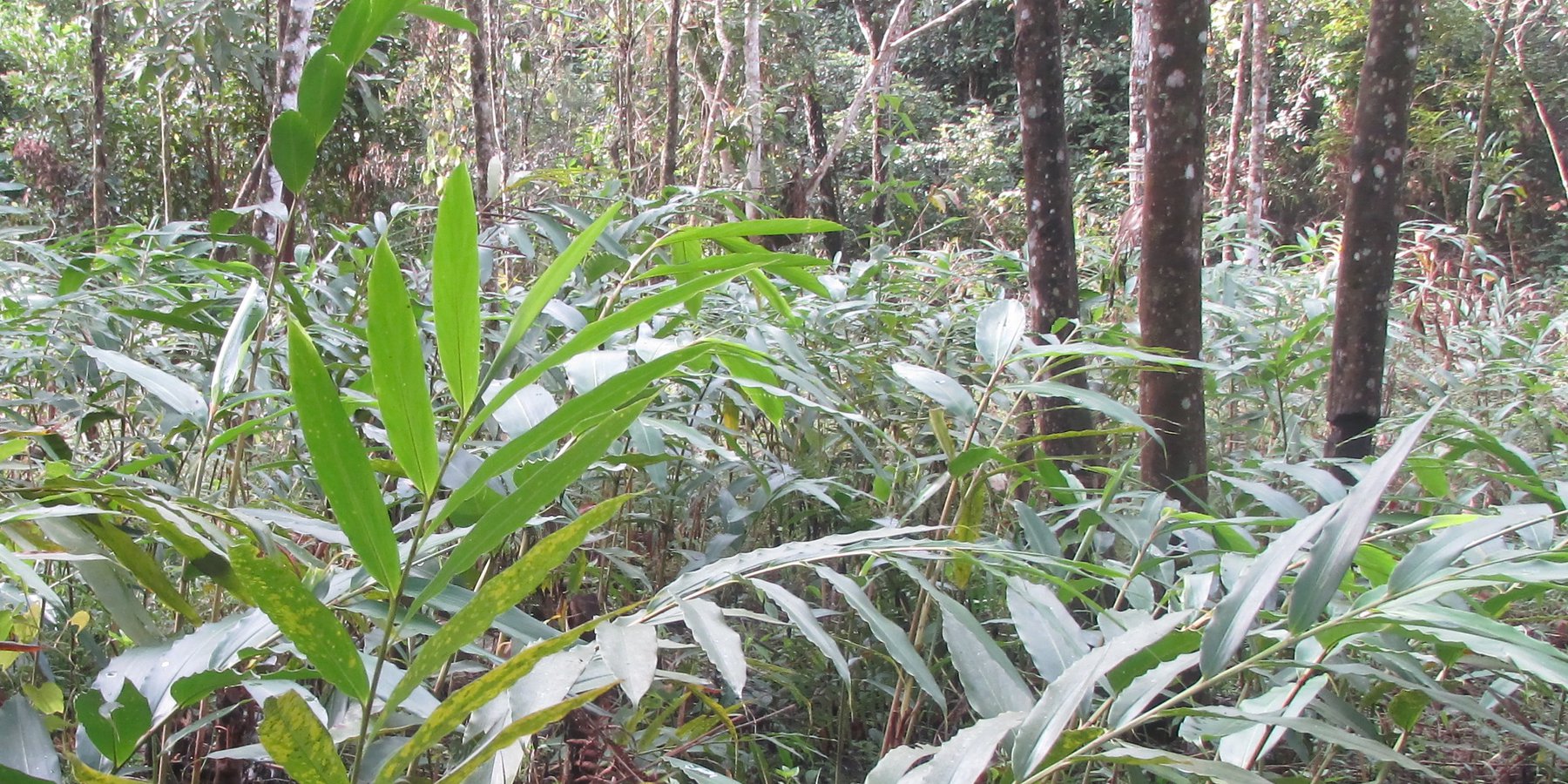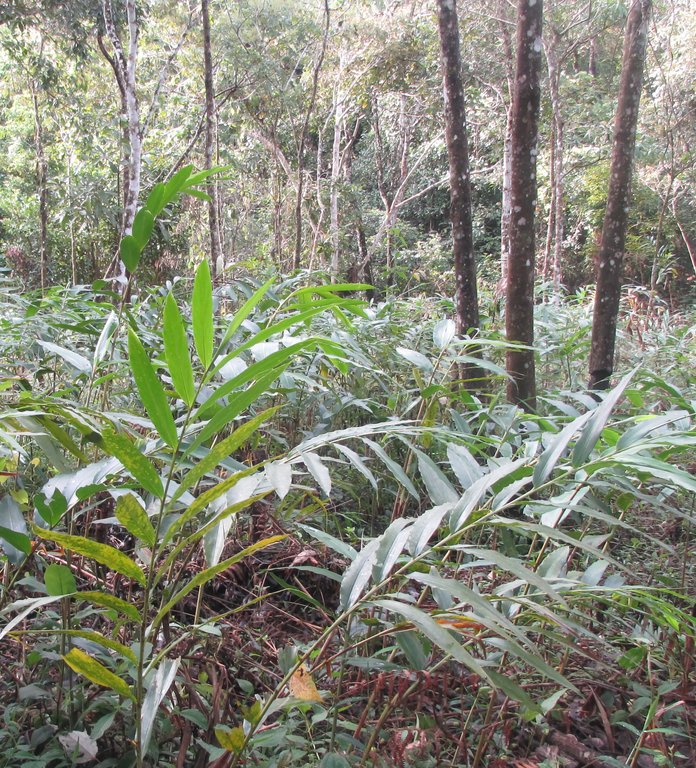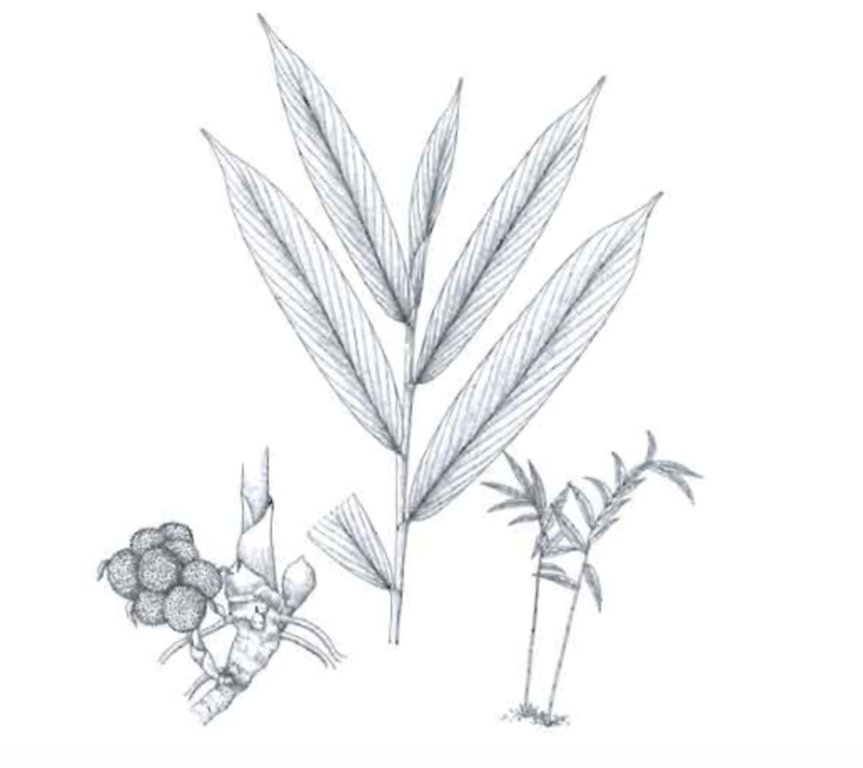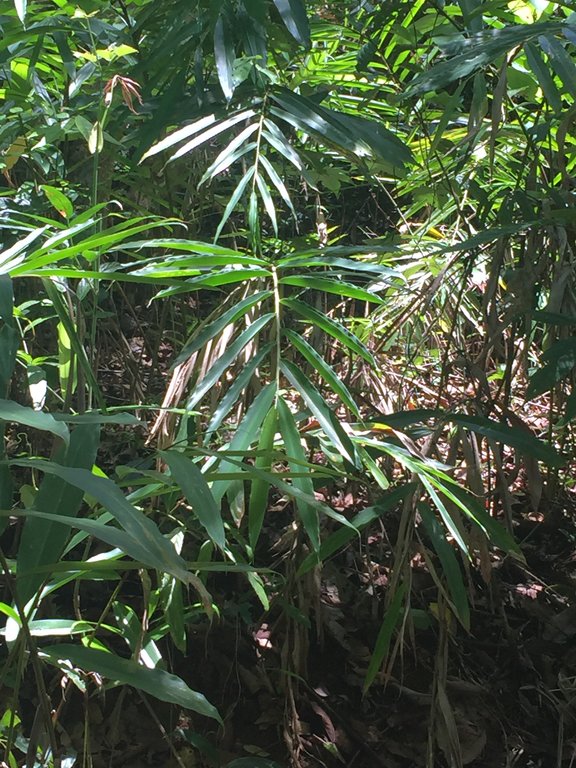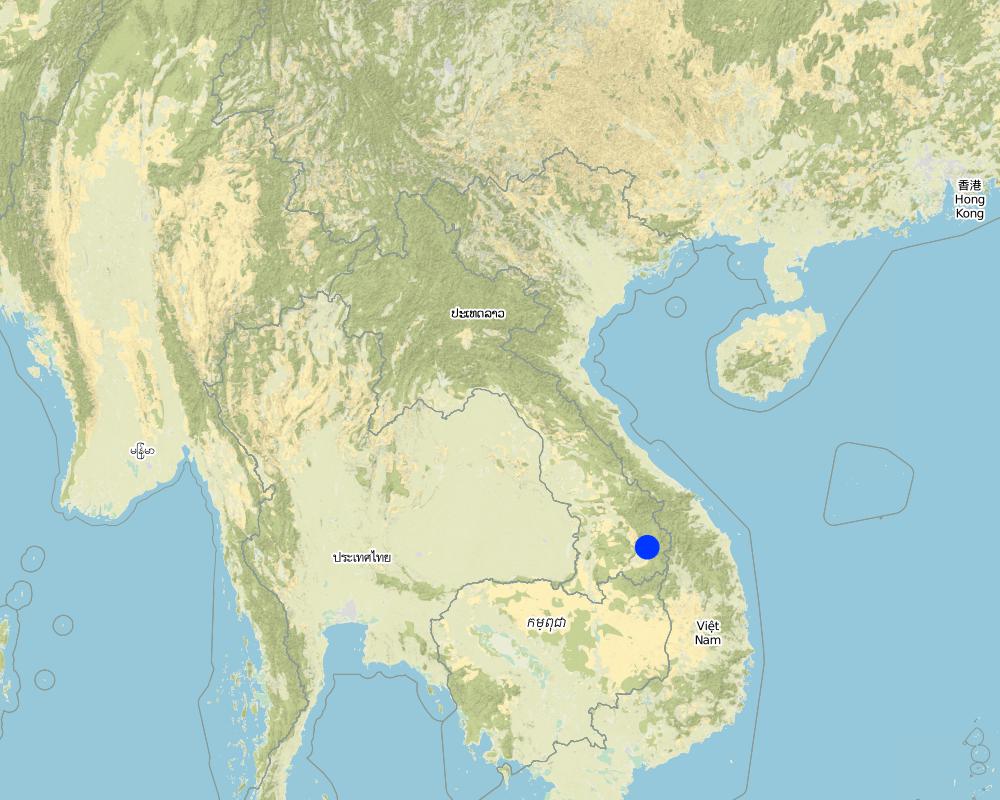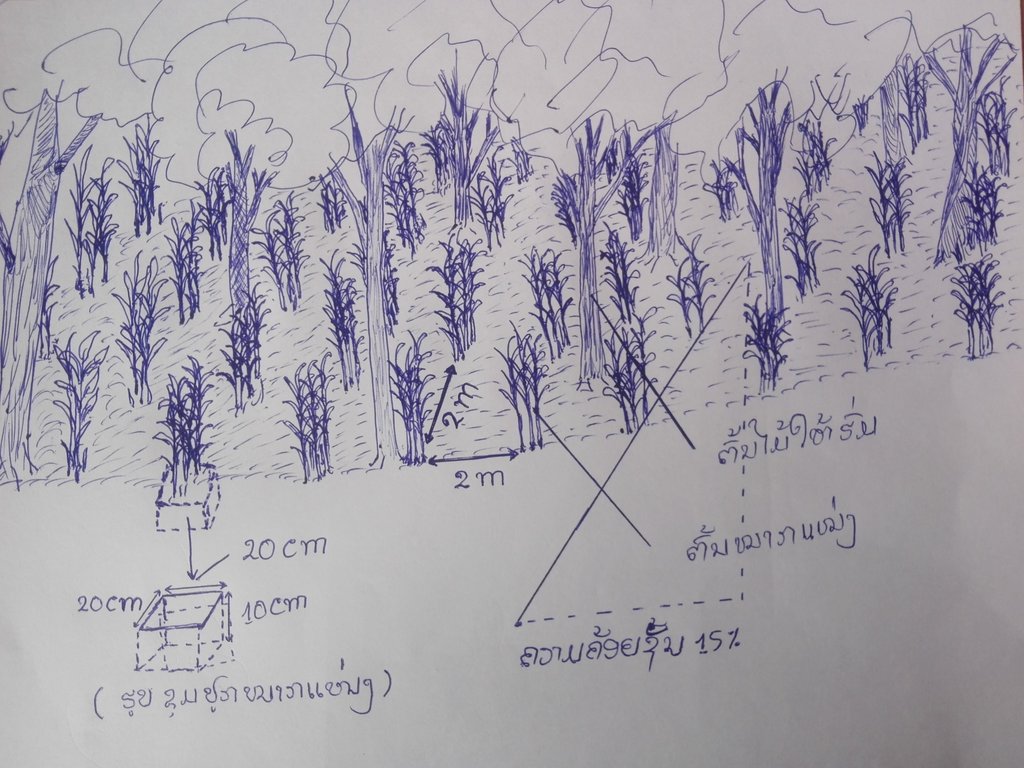ການປູກໝາກແໜ່ງພື້ນເມືອງ ເພື່ອການຈັດການ ຄຸ້ມຄອງ ປ່າໄມ້ ແບບຍືນຍົງ [Lao People's Democratic Republic]
- Creation:
- Update:
- Compiler: Bounthanom Bouahom
- Editors: Bounthanom Bouahom, sinnilong vongkhamchanh
- Reviewers: viengsavanh phimphachanhvongsod, Nicole Harari, Stephanie Jaquet, Alexandra Gavilano
technologies_2237 - Lao People's Democratic Republic
View sections
Expand all Collapse all1. General information
1.2 Contact details of resource persons and institutions involved in the assessment and documentation of the Technology
Key resource person(s)
land user:
ຜູ້ສັງລວມຂໍ້ມູນ:
Lao People's Democratic Republic
ບຸດດາທົນ ບົວທອງ
ເປັນປະຊາຊົນ
Lao People's Democratic Republic
Name of project which facilitated the documentation/ evaluation of the Technology (if relevant)
Scaling-up SLM practices by smallholder farmers (IFAD)Name of the institution(s) which facilitated the documentation/ evaluation of the Technology (if relevant)
National Agriculture and Forestry Research Institute (NAFRI) - Lao People's Democratic Republic1.3 Conditions regarding the use of data documented through WOCAT
The compiler and key resource person(s) accept the conditions regarding the use of data documented through WOCAT:
Ja
1.4 Declaration on sustainability of the described Technology
Is the Technology described here problematic with regard to land degradation, so that it cannot be declared a sustainable land management technology?
Nee
2. Description of the SLM Technology
2.1 Short description of the Technology
Definition of the Technology:
ໝາກແໜ່ງ ເປັນເຄື່ອງປ່າຂອງດົງ ປະເພດໜື່ງ ຊຶ່ງມັກພົບເຫັນ ໃນປ່າທຳມະຊາດ ຢູ່ບ່ອນທີ່ເຄີຍໄດ້ມີ ການຈູດປ່າຖາງປ່າເຮັດໄຮ່ ເພື່ອເຮັດການຜະລິດ. ຈຸດປະສົງ ຂອງເຕັກນິກ ການປູກໝາກແໜ່ງ ຢູ່ເຂດຄ້ອຍຊັນ ແມ່ນເພື່ອເປັນການນຳໃຊ້, ຈັດການຄຸ້ມຄອງ ປ່າໄມ້ ແບບຍືນຍົງ ແລະ ທັງສາມາດ ສ້າງລາຍຮັບ ໃຫ້ແກ່ຄອບຄົວ.
2.2 Detailed description of the Technology
Description:
ຫມາກແຫນ່ງ ແມ່ນເຄ່ືອງປ່າຂອງດົງ ປະເພດຫນ່ືງ ທ່ີເກີດຂ້ຶນເອງ ຕາມທໍາມະຊາດ ມີຄວາມສູງ ຈາກລະດັບ ຫນ້ານໍາ້ທະເລ 600 - 1200 ແມັດ, ເກີດຢູ່ບ່ອນ ທີມີອາກາດ ຊຸ່ມເຢັນ ແລະ ມີແສງແດດຫນ້ອຍ ຊ່ຶງມັນ ຈະເລິນເຕີບໂຕ ໄດ້ດີໃນຮົ່ມກອ້ງຕົ້ນໄມ້ (ອຸນຫະພູມ ສະເລ່ຍ 15-25 ອົງສາ, ຄ່າ PH= 5,5 - 6,5). ໃນເມືອກ່ອນ ປະຊາຊົນ ເຄີຍພົບເຫັນ ແຕ່ບໍ່ເຄີຍ ໄດ້ເກັບກູ້ ຫືຼ ເອົາມາໃຊ້ ເນືອງຈາກບໍ່ເປັນສິນຄ້າ. ຕົກມາ ເຖິງຊມຸ ປີ 2000, ໄດ້ມີພໍ່ຄ້າ ເຂົ້າມາຖາມຊ້ຶ ແລະ ເຫັນວ່າ ຕະຫຼາດ ກໍ່ມີຄວາມຕອ້ງການຫຼາຍ ຊ່ຶງປັດໃຈດັ່ງ ກ່າວນັ້ນມັນ ໄດ້ເຮັດໃຫ້ປະຊາຊົນ ພາຍໃນທອ້ງຖ່ີນ ໄດ້ພາກັນໄປເກັບຫມາກແຫນ່ງ ຈາກປ່າຫຼາຍຂ້ືນ ເພື່ອນໍາມາຂາຍ ສ້າງລາຍຮັບ ໃຫ້ແກ່ຄອບຄົວ ຊ່ືງສົ່ງຜົນເຮັດໃຫ້ ປະລິມານ ຜົນຜະລິດ ຫມາກແຫນ່ງ ໃນປ່າຫຸຼດລົງ ແລະ ເກີດມີບັນຫາ ການຍາດແຍ່ງແຂ່ງຂັນກັນ. ດັ່ງນັ້ນ, ປະຊາຊົນ ພາຍໃນທອ້ງຖ່ີນ ຈ່ຶງໄດ້ລິເລ່ີມ ນໍາເອົາເບ້ຍຫມາກແຫນ່ງ ຢູ່ໃນປ່າ ມາປູກໃສ່ໄຮ່ ບ່ອນທ່ີເຮັດປູກເຂົ້າໃສ່ມາກ່ອນ. ປົກກະຕິແລ້ວ ພາຍຫັຼງ ເກັບກ່ຽວຜົນ ຜະລິດເຂົ້າ ປະຊາຊົນ ກໍ່ຈະນໍາເອົາເບ້ຍ ຫມາກແຫນ່ງ ມາປູກໃສ່ເລີຍ. ໃນປີ 2002, ເຫັນໄດ້ວ່າ ຊາວກະສິກອນ ສາມາດ ເກັບກູ້ໝາກແຫນ່ງ ຈາກສວນປູກ. ການປູກຫມາກແຫນ່ງ ແມ່ນບ່ໍໄດ້ໃຊ້ຕົ້ນທຶນສູງ ມີແຕ່ຊ້ືຈົກ, ພ້າ ແລະ ກະສອບ ເພື່ອ ໃຊ້ເຂົ້າໃນການໄປຂຸດ ເອົາເບ້ຍ ຫມາກແຫນ່ງ ຢູ່ປ່າມາປູກ. ເນ້ືອທ່ີປູກຫມາກແຫນ່ງ 1 ເຮັກຕາ ແມ່ນໃຊ້ເວລາ15 ມ້ື ໃນການໄປຊອກຂຸດເບ້ຍໝາກແຫນ່ງຢູ່ປ່າ. ການຄັດເລືອກຂຸດ ເບ້ຍຫມາກແຫນ່ງ ທ່ີຈະນໍາມາປູກຕ້ອງ ເປັນເບ້ຍ ທ່ີຂອ້ນຂາ້ງແກ່, ມີໃບສີຂຽວເຂັ້ມ ທ່ີມີໃບເຫືຼອງປະປົນຢູ່ 1-2 ໃບ, ມີຄວາມສູງຂອງຕົ້ນ ປະມານ 1-2 ແມັດ ມີການຂະຫຍາຍ ແຕກຫນ່ໍແຫນງດີ, ທົນທານ ຕໍ່ການເຄ່ືອນຍາ້ຍ, ທົນທານ ຕໍ່ສະພາບອາກາດ ແລະ ອຸນ ຫະພູມ ໃນຊ່ວງໄລຍະ ທ່ີປູກໃຫມ່ ຊ່ືງເບ້ຍ ຫມາກແຫນ່ງ ທ່ີຂຸດມາ ຕອ້ງໄດປູກທັນທີ ພາຍຫັຼງ ທ່ີໄດ້ຂຸດມາ ຫືຼ ຊາ້ສຸດບ່ໍໃຫ້ກາຍ 2 ມ້ື. ໂດຍສ່ວນໃຫຍ່ ປະຊາຊົນສາມາດ ປູກຫມາກແຫນ່ງ ເລ້ີມຕັ້ງແຕ່ເດືອນມີຖຸນາ ເຖິງ ເດືອນກໍລະກົດ ຂອງທຸກໆປີ ຍາມຝົນຕົກ. ກ່ອນເດືອນພຶດສະພາ, ປະຊາຊົນ ຕອ້ງໄດ້ມີການກະກຽມ ຖາກຖາງ ພື້ນທ່ີ ແຕ່ຕອ້ງຖາກຖາງ ແບບຮັກສາຮົ່ມໄວ້ 40% ຂອງເນ້ືອທ່ີ ເປັນການຖາງ ແບບຈົ່ງຕົ້ນໄມ້ໃຫຍ່ໄວ້ ເພື່ອບັງແສງແດດ ຫືຼຮັກສາຕົ້ນໄມ້ ທ່ີໃຫ້ຮົ່ມ ເພື່ອສາມາດ ບັງແສງແດດໄດ້ ແຕ່ກໍ່ບໍ່ໃຫ້ຮົ່ມ ຈົນເກີນໄປ ຫືຼ ບໍ່ໃຫ້ແດດຈົນເກີນໄປ ຖຶໄດ້ວ່າ ເຕັກນິກ ວິທີການຖາງດັ່ງກ່າວ ຕອ້ງໄດ້ອາໃສ ການສັງເກດ ແລະ ຄວາມຮູ້ປະສົບການ ຂອງຜູ້ນຳໃຊທີ່ດິນເອງ. ເຕັກນິກການປູກ ແມ່ນປູກແບບເປັນຖັນ, ເປັນແຖວ ເຊັ່ນ: ໄລຍະຫ່າງຂອງຕົ້ນ ແມ່ນ 1 ແມັດ ,ໄລຍະຫ່າງ ຂອງແຖວແມ່ນ 1,2 ແມັດ, ຂຸມຂະຫນາດ 20x20 ຊັງຕິແມັດ, ຄວາມເລິກຂອງຂຸມ 10x 15 ຊັງຕິແມັດ, ຄວາມຫ່າງຂອງຕົ້ນ 2 x 2 ແມັດ ເພື່ອສະດວກ ໃນການເກັບກ່ຽວ ຜົນຜະລິດ ແລະ ການບົວລະບັດ ຮັກສາ, ການຖາກຖາງອານາໄມວັດສະພືດຕ່າງໆ ໃນສວນ. ໂດຍສ່ວນໃຫຍ່ ແມ່ນປູກ 3 ເບຍ້/ຊມຸ ຈະເປັນການດີ ສະເລ່ຍ 2500 ຂຸມ/ເຮັກຕາ ປະມານ 7500 ເບ້ຍ/ເຮັກຕາ. ປະຊາຊົນ ບໍ່ໄດ້ໃຊ້ຝຸ່ນ ໃນສວນໝາກແຫນ່ງ ມີແຕ່ເອົາໃຈໃສ່ ບົວລະບດັ ຮັກສາຕັດງ່າອານາໄມ ສວນປູກຢູ່ເລ້ືອຍໆ. ຕົ້ນຫມາກແຫນ່ງ ຈະໃຫ້ຜົນຜະລິດ ພາຍຫັຼງ ຈາກການປູກ ໃຊ້ເວລາ 4 ປີ, ການປູກຫມາກແຫນ່ງ ແມ່ນເປັນການເພີ່ມວຽກ ໃຫ້ປະຊາຊົນ ເນ່ືອງຈາກວ່າ ພວກເຂົາຕອ້ງໄດ້ໃຊ້ເວລາ ໄປຊອກຂຸດເບ້ຍ ຫມາກແຫນ່ງ ຢູ່ປ່າ. ໂດຍສ່ວນໃຫຍ່ ການເກັບກູຫມາກແຫນ່ງ ຈະເກັບໃນຊ່ວງ ເດືອນສິງຫາ ເຖິງ ເດືອນກັນຍາ ຂອງທຸກໆປີ, ສະມັດຕະພາບ ຜົນຜະລິດ ຂອງຫມາກແຫນ່ງ ປະມານ 320 ກິໂລ/ເຮັກຕາ (ສໍາລັບຫມາກແຫ້ງ) ແລະ ຜົນຜະລິດ ຂອງຫມາກປຽກ ປະມານ 578 ກິໂລ/ເຮັກຕາ. ທາງດາ້ນການຕະຫຼາດ ແມ່ນມີຄວາມສະດວກ ແລະ ປະຊາຊົນ ກໍ່ມີຄວາມພຶງພໍໃຈ ເພາະມີພໍ່ຄ້າຄົນກາງ ມາເກັບຊ້ື ເຖີງທ່ີ (70.000 ກີບ/ກິໂລ). ຜົນທ່ີໄດ້ຮັບ ຈາກການປູກຫມາກແຫນ່ງ ສາມາດ ສ້າງລາຍຮັບ ໃຫ້ປະຊາຊົນທອ້ງຖ່ີນ, ສາມາດ ເພີ່ມເນ້ືອທ່ີ ການປົກຄຸມ ຂອງປ່າໄມ້ໄດ້ ຫຸຼດຜອ່ນ ການຖາງປ່າເຮັດໄຮ່ ແບບເລືອນລອຍ, ຫຸຼດຜອ່ນ ການບຸກລຸກ ພື້ນທ່ີທໍາການຜະລິດ. ນອກຈາກນ້ີ, ກ່ໍຍັງສາມາດ ສ້າງຄວາມສົມດູນ ໃຫ້ລະບົບນິເວດ ແລະ ເປັນແຫ່ຼງທ່ີຢູ່ອາໃສ ຂອງຊີວະນາໆ ພັນ ໃນປ່າໃມ້ ໃຫ້ມີຄວາມອຸດົມສົມບູນ.
2.3 Photos of the Technology
2.5 Country/ region/ locations where the Technology has been applied and which are covered by this assessment
Country:
Lao People's Democratic Republic
Region/ State/ Province:
ແຂວງອັດຕະປື
Further specification of location:
ເມືອງຊານໄຊ
Specify the spread of the Technology:
- evenly spread over an area
If precise area is not known, indicate approximate area covered:
- < 0.1 km2 (10 ha)
Map
×2.6 Date of implementation
Indicate year of implementation:
2010
If precise year is not known, indicate approximate date:
- less than 10 years ago (recently)
2.7 Introduction of the Technology
Specify how the Technology was introduced:
- through land users' innovation
3. Classification of the SLM Technology
3.1 Main purpose(s) of the Technology
- conserve ecosystem
- preserve/ improve biodiversity
- create beneficial economic impact
3.2 Current land use type(s) where the Technology is applied

Cropland
- Tree and shrub cropping
Number of growing seasons per year:
- 1
3.4 Water supply
Water supply for the land on which the Technology is applied:
- rainfed
3.5 SLM group to which the Technology belongs
- agroforestry
- ecosystem-based disaster risk reduction
3.6 SLM measures comprising the Technology

vegetative measures
- V1: Tree and shrub cover

management measures
- M1: Change of land use type
3.7 Main types of land degradation addressed by the Technology

biological degradation
- Bh: loss of habitats
- Bq: quantity/ biomass decline
3.8 Prevention, reduction, or restoration of land degradation
Specify the goal of the Technology with regard to land degradation:
- prevent land degradation
4. Technical specifications, implementation activities, inputs, and costs
4.1 Technical drawing of the Technology
Technical specifications (related to technical drawing):
ຊາວກະສິກອນ ກະກຽມດິນ ໃຊ້ວລາ ປະມານ 5 ມ້ື ໃນເດືອນພຶດສະພາ ໂດຍເລ່ີມຖາງອານາໄມ ພື້ນທ່ີ ແຕ່ໄດ້ຈົ່ງຕົ້ນໄມ້ໃຫຍ່ ເພື່ອໃຫ້ເປັນຮົ່ມ ແລະ ເປັນຟຸ່ມໄມ້ ເພື່ອປ້ອງກັນແສງແດດ. ຕົກມາຮອດ ເດືອນມີຖຸນາ ເຖິງ ເດືອນກໍລະກົດ ຊ່ຶງເປັນລະດູຝົນ ກ່ໍໄປຊອກຫາເບ້ຍ ຫມາກແຫນ່ງ ຢູ່ປ່າ ໂດຍໃຊ້ເວລາປະ ມານ15 ວນັ (ໃຊ້ແຮງງານ 2 ຄົນ), ເລືອກຂະຫນາດ ລໍາຕົ້ນສູງ ປະມານ 1-2 ແມັດ. ຂຸດຂຸມ ຂະຫນາດ ຄວາມກວາ້ງ 20 x 20 ຊັງຕິແມັດ, ຄວາມເລີກ 10-15 ຊັງຕິແມັດ, ໄລຍະຫ່າງ ຂອງຂຸມ 2x2 ແມັດ ສະຫລັບຕາມຫວ່າງ ຂອງຕົ້ນໄມ້, ປູກ 3 ເບຍ້ /ຂຸມ (ສະເລ່ຍມີ 2500 ຂຸມ/ເຮັກຕາ). ຄວາມຄອ້ຍຊັນ ຂອງພື້ນທ່ີປູກແມ່ນ 15%. ບ່ໍໄດ້ໃຊ້ປຸຍໃດໆ ໃນກໍລະນີ ສວນປູກຫມາກແຫນ່ງນ້ີ ໃຊ້ພຽງແຕ່ຝຸ່ນຄອກ.
Author:
ສິນນິລົງ ວົງຄຳຈັນ
Date:
13/05/2017
4.2 General information regarding the calculation of inputs and costs
Specify how costs and inputs were calculated:
- per Technology area
Indicate size and area unit:
1 ເຮັກຕາ
other/ national currency (specify):
ກີບ
If relevant, indicate exchange rate from USD to local currency (e.g. 1 USD = 79.9 Brazilian Real): 1 USD =:
8000.0
Indicate average wage cost of hired labour per day:
50.000
4.3 Establishment activities
| Activity | Timing (season) | |
|---|---|---|
| 1. | ກະກຽມດິນ ແລະ ຖາງອານາໄມ ພື້ນທີ່ | ເດືອນເມສາ ຫາ ເດືອນພືດສະພາ |
| 2. | ການອະນະໄມ ເສດກິ່ງໄມ້ | ເດືອນພຶດສະພາ (ກ່ອນປູກ) |
| 3. | ຊອກຂຸດເບ້ຍ ໝາກແໜ່ງ ຢູ່ປ່າ | ເດືອນມີຖຸນາ ຫາ ເດືອນກໍລະກົດ |
| 4. | ນຳເບ້ຍໝາກແໜ່ງ ມາປູກ | ເດືອນກໍລະກົດ |
4.4 Costs and inputs needed for establishment
| Specify input | Unit | Quantity | Costs per Unit | Total costs per input | % of costs borne by land users | |
|---|---|---|---|---|---|---|
| Labour | ແຮງງານ ກະກຽມດິນ | ວັນງານ | 10.0 | 50000.0 | 500000.0 | 100.0 |
| Labour | ແຮງງານ ໄປຂຸດເບ້ຍໝາກແໜ່ງ ຢູ່ປ່າ | ວັນງານ | 30.0 | 50000.0 | 1500000.0 | 100.0 |
| Labour | ແຮງງານ ໃນການປູກ | ວັນງານ | 10.0 | 50000.0 | 500000.0 | 100.0 |
| Equipment | ຟ້າ | ດວງ | 3.0 | 60000.0 | 180000.0 | 100.0 |
| Equipment | ຈົກ | ດວງ | 3.0 | 80000.0 | 240000.0 | 100.0 |
| Equipment | ກະຕ່າ ໃສ່ເບ້ຍໝາກແໜ່ງ | ໜ່ວຍ | 3.0 | 150000.0 | 450000.0 | 100.0 |
| Equipment | ກະສອບ ໃສ່ເບ້ຍໝາກແໜ່ງ | ສອບ | 30.0 | 2500.0 | 75000.0 | 100.0 |
| Fertilizers and biocides | ຝຸ່ນຄອກ | ກິໂລ | 2500.0 | 300.0 | 750000.0 | 100.0 |
| Total costs for establishment of the Technology | 4195000.0 | |||||
| Total costs for establishment of the Technology in USD | 524.38 | |||||
4.5 Maintenance/ recurrent activities
| Activity | Timing/ frequency | |
|---|---|---|
| 1. | ການເສຍຫຍ້າ | ເດືອນມີນາ ຫາ ເດືອນເມສາ (1 ຄັ້ງ/ປີ) |
| 2. | ໃສ່ຝຸ່ນຄອກ | ພາຍຫຼັງເກັບຜົນຜະລິດ |
| 3. | ເກັບກູ້ໝາກແໜ່ງ | ເດືອນສິງຫາ ຫາ ເດືອນກັນຍາ |
4.6 Costs and inputs needed for maintenance/ recurrent activities (per year)
| Specify input | Unit | Quantity | Costs per Unit | Total costs per input | % of costs borne by land users | |
|---|---|---|---|---|---|---|
| Labour | ແຮງງານ ເສຍຫຍ້າ | ວັນງານ | 10.0 | 50000.0 | 500000.0 | 100.0 |
| Labour | ແຮງງານ ໃສ່ຝຸ່ນ | ວັນງານ | 10.0 | 50000.0 | 500000.0 | 100.0 |
| Labour | ແຮງງານ ເກັບກູ້ | ວັນງານ | 10.0 | 50000.0 | 500000.0 | 100.0 |
| Fertilizers and biocides | ຝຸ່ນຄອກ | ກິໂລ | 300.0 | 2500.0 | 750000.0 | 100.0 |
| Total costs for maintenance of the Technology | 2250000.0 | |||||
| Total costs for maintenance of the Technology in USD | 281.25 | |||||
4.7 Most important factors affecting the costs
Describe the most determinate factors affecting the costs:
ແຮງງານ ໃນການໄປຂຸດເບ້ຍ ຫມາກແຫນ່ງ ແລະ ຕົ້ນທຶນ ໃນການຊ້ຶຝຸ່ນຄອກ ເປັນປັດໃຈທ່ີສົ່ງຜົນ ເຮັດໃຫ້ຕົ້ນທຶນສູງ ໃນການເຮັດເຕັກນິກດັ່ງກ່າວ.
5. Natural and human environment
5.1 Climate
Annual rainfall
- < 250 mm
- 251-500 mm
- 501-750 mm
- 751-1,000 mm
- 1,001-1,500 mm
- 1,501-2,000 mm
- 2,001-3,000 mm
- 3,001-4,000 mm
- > 4,000 mm
Agro-climatic zone
- sub-humid
5.2 Topography
Slopes on average:
- flat (0-2%)
- gentle (3-5%)
- moderate (6-10%)
- rolling (11-15%)
- hilly (16-30%)
- steep (31-60%)
- very steep (>60%)
Landforms:
- plateau/plains
- ridges
- mountain slopes
- hill slopes
- footslopes
- valley floors
Altitudinal zone:
- 0-100 m a.s.l.
- 101-500 m a.s.l.
- 501-1,000 m a.s.l.
- 1,001-1,500 m a.s.l.
- 1,501-2,000 m a.s.l.
- 2,001-2,500 m a.s.l.
- 2,501-3,000 m a.s.l.
- 3,001-4,000 m a.s.l.
- > 4,000 m a.s.l.
Indicate if the Technology is specifically applied in:
- not relevant
5.3 Soils
Soil depth on average:
- very shallow (0-20 cm)
- shallow (21-50 cm)
- moderately deep (51-80 cm)
- deep (81-120 cm)
- very deep (> 120 cm)
Soil texture (topsoil):
- medium (loamy, silty)
Soil texture (> 20 cm below surface):
- fine/ heavy (clay)
Topsoil organic matter:
- low (<1%)
5.4 Water availability and quality
Ground water table:
> 50 m
Availability of surface water:
medium
Water quality (untreated):
poor drinking water (treatment required)
Is water salinity a problem?
Nee
Is flooding of the area occurring?
Nee
5.5 Biodiversity
Species diversity:
- medium
Habitat diversity:
- medium
5.6 Characteristics of land users applying the Technology
Sedentary or nomadic:
- Sedentary
Market orientation of production system:
- commercial/ market
Off-farm income:
- less than 10% of all income
Relative level of wealth:
- rich
Individuals or groups:
- individual/ household
Level of mechanization:
- manual work
Gender:
- women
- men
Age of land users:
- youth
- middle-aged
5.7 Average area of land used by land users applying the Technology
- < 0.5 ha
- 0.5-1 ha
- 1-2 ha
- 2-5 ha
- 5-15 ha
- 15-50 ha
- 50-100 ha
- 100-500 ha
- 500-1,000 ha
- 1,000-10,000 ha
- > 10,000 ha
Is this considered small-, medium- or large-scale (referring to local context)?
- medium-scale
5.8 Land ownership, land use rights, and water use rights
Land ownership:
- individual, not titled
Land use rights:
- individual
- ນຳໃຊ້ນ້ຳຝົນ
5.9 Access to services and infrastructure
health:
- poor
- moderate
- good
education:
- poor
- moderate
- good
technical assistance:
- poor
- moderate
- good
employment (e.g. off-farm):
- poor
- moderate
- good
markets:
- poor
- moderate
- good
energy:
- poor
- moderate
- good
roads and transport:
- poor
- moderate
- good
drinking water and sanitation:
- poor
- moderate
- good
financial services:
- poor
- moderate
- good
6. Impacts and concluding statements
6.1 On-site impacts the Technology has shown
Socio-economic impacts
Income and costs
farm income
Comments/ specify:
ສາມາດສ້າງລາຍຮັບເພີ່ມ ຈາກການຂາຍ ຫມາກແຫນ່ງ
diversity of income sources
Comments/ specify:
ເພີ່ມລາຍຮັບ ຈາກການຂາຍຫມາກແຫນ່ງຫຼາຍຂ້ືນ ເພາະໃນເມ່ືອກ່ອນ ປະຊາຊົນ ບໍ່ເຄີຍໄດ້ເກັບໝາກແຫນ່ງ ມາຂາຍເປັນສິນຄາ້.
workload
Comments/ specify:
ປະຊາຊົນ ມີສວນປູກຫມາກແຫນ່ງ ຢູ່ໄກ້ບ້ານ ແລະ ບ່ໍໄດ້ເສຍເວລາ ອອກໄປເກັບໝາກແຫນ່ງຢູ່ປ່າ.
Socio-cultural impacts
conflict mitigation
Comments/ specify:
ຫຸຼດຜອ່ນບັນຫາ ຄວາມຂັດແຍ່ງ ໃນການໄປຂຸດຫມາກແຫນ່ງ ຢູ່ປ່າທໍາມະຊາດ ເນ່ືອງຈາກຊາວກະສິກອນ ປູກຫມາກແຫນ່ງ ໃສ່ສວນໃຜລາວ.
Ecological impacts
Soil
soil moisture
Biodiversity: vegetation, animals
plant diversity
Comments/ specify:
ມີເຫັດ ແລະ ເທົາເກີດຂ້ຶນ ໃນພື້ນທີ່ສວນປູກໝາກແໜ່ງ
invasive alien species
Comments/ specify:
ເປັນປ່າ ຮົກເຮ້ືອ ເກີດມີຍູງ ແລະ ງູຫຼາຍຂ້ືນ
habitat diversity
Comments/ specify:
ເກີດມີຂ້ີກະເດືອນ ແລະ ບົ້ງກື
6.2 Off-site impacts the Technology has shown
impact of greenhouse gases
Comments/ specify:
ເປັນການປົກປັກຮັກສາ ຊັບພະຍາກອນປ່າໄມ້ ໂດຍການປູກຫມາກແຫນ່ງໃສ່ ຊຶ່ງສາມາດ ເກັບກູຫມາກແຫນ່ງ ໄດ້ເຖິງ 15 ປີ ພາຍຫັຼງ ການປູກ. ຊຶ່ງເປັນການຫຸຼດຜອ່ນ ການຖາງປ່າຊະຊາຍ ເພື່ອເຮັດໄຮ່ເຂົ້າໃສ່ດິນບ່ອນເກົ່າ, ພອ້ມທັງຫຸຼດຜອ່ນ ບັນຫາການຈຸດປ່າຖາງໄຮ່.
6.3 Exposure and sensitivity of the Technology to gradual climate change and climate-related extremes/ disasters (as perceived by land users)
Gradual climate change
Gradual climate change
| Season | increase or decrease | How does the Technology cope with it? | |
|---|---|---|---|
| annual rainfall | decrease | well | |
| seasonal rainfall | winter | decrease | moderately |
6.4 Cost-benefit analysis
How do the benefits compare with the establishment costs (from land users’ perspective)?
Short-term returns:
slightly positive
Long-term returns:
positive
How do the benefits compare with the maintenance/ recurrent costs (from land users' perspective)?
Short-term returns:
slightly positive
Long-term returns:
positive
6.5 Adoption of the Technology
- 11-50%
Of all those who have adopted the Technology, how many did so spontaneously, i.e. without receiving any material incentives/ payments?
- 91-100%
6.6 Adaptation
Has the Technology been modified recently to adapt to changing conditions?
Nee
6.7 Strengths/ advantages/ opportunities of the Technology
| Strengths/ advantages/ opportunities in the land user’s view |
|---|
| ສາມາດ ຫຸຼດຜ່ອນ ບັນຫາຂໍ້ຂັດແຍ່ງ ໃນການເກັບກູ້ຫມາກແຫນ່ງ ຢູ່ປ່າທໍາມະຊາດ |
| ສາມາດ ເພີ່ມເນ້ືອທ່ີ ປົກຄຸມ ປ່າໄມ້ ໃຫ້ຫຼາຍຂ້ຶນ |
| ສາມາດ ຟ້ືນຟູ ບັນຫາດິນເຊ່ືອມໂຊມ ຈາກກິດຈະກໍາ ຖາງປ່າເຮັດໄຮ່ ແບບເລ່ືອນລອຍ |
| Strengths/ advantages/ opportunities in the compiler’s or other key resource person’s view |
|---|
| ສາມາດ ປົກປັກຮັກສາ ຊັບພະຍາກອນ ປ່າໄມ້ ແລະ ປັບປຸງ ລະບົບນິເວດວິທະຍາ ໂດຍການຫມາກແຫນ່ງພື້ນເມືອງ ບ່ໍໃຫ້ສູນພັນ. |
| ຫຸຼດຜ່ອນ ການເຂົ້າປ່າໄປ ເກັບກູ້ ຫມາກແຫນ່ງ ຢູ່ປ່າໄມ້ ທໍາມະຊາດ ແຕ່ພອ້ມດຽວກັນນັ້ນ ກ່ໍໄດ້ເພີ່ມເນື້ອທີ່ປູກໝາກແຫນ່ງ ໃສ່ໄຮ່ຄົງທ່ີ. |
6.8 Weaknesses/ disadvantages/ risks of the Technology and ways of overcoming them
| Weaknesses/ disadvantages/ risks in the land user’s view | How can they be overcome? |
|---|---|
| ພາຍຫັຼງ ປູກຫມາກແຫນ່ງ ໃສ່ສວນແລ້ວ ແມ່ນເປັນປ່າຮົກເຮື້ອຫຼາຍ ພາໃຫ້ເກີດມີຍຸງ ແລະ ງູຫຼາຍ. | |
| ສວນຫມາກແຫນ່ງ ເປັນປ່າຕຶບຫນາ ຊ່ຶງສ້າງຄວາມລໍາບາກ ໃນການເຂົ້າໄປ ເກັບກູ້ ຜົນຜະລິດ ຫມາກແຫນ່ງ ຢູ່ສວນ ເພາະຕອ້ງໄດ້ກົ້ມເກັບຫມາກແຫນ່ງ. | |
| ການຈັດຕັງປະຕິບັດ ນະໂຍບາຍ ຢຸດຕິການຖາງປ່າເຮັດໄຮ່ ເປັນຂໍ້ຈຳກັດ ໃຫ້ປະຊາຊົນ ໃນການເຂົ້າປ່າ ໄປຂຸດເບ້ຍຫມາກແຫນ່ງ. |
7. References and links
7.1 Methods/ sources of information
- field visits, field surveys
1
- interviews with land users
1
When were the data compiled (in the field)?
12/05/2017
Links and modules
Expand all Collapse allLinks
No links
Modules
No modules


